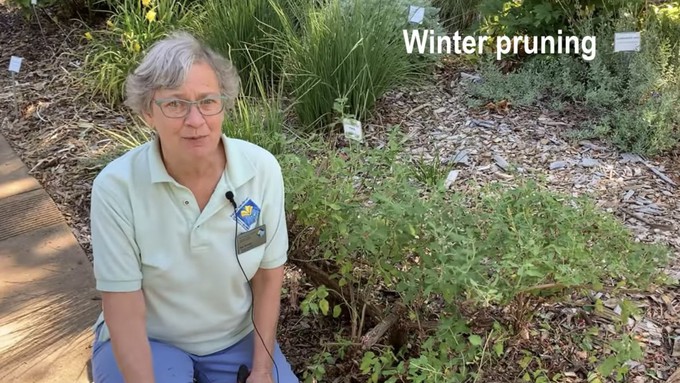
Topics include salvias, blueberries, grasses and more

Sacramento County master gardener Pat Schink explains winter pruning of woody sages, aka salvias, in a video available on YouTube. Screen grab from "Pruning Woody Sages," UCCE Master Gardeners of Sacramento County
No need to look far for great gardening advice: The Sacramento County group of master gardeners, not to mention other counties in California, have produced terrific -- and short -- videos on all kinds of topics.
This time of year the A-Number One topic is pruning, of course. Trees, roses, perennials, berry bushes all are dormant and can be pruned.
But pruning a plant you've invested time and money in can be scary to some people. What if it's ruined forever? They fret and then don't do anything. But ignoring pruning may ultimately hurt more than help that plant.
Below are suggestions on videos to watch that will explain the pruning process succinctly. But first, a few plants that should NOT be pruned during winter:
-- Apricot and cherry trees. Pruning cuts on these trees are susceptible infection from a fungus (Eutypa) and bacterial canker diseases that flourish in wet weather. Save those pruning duties for late summer.
-- Citrus trees. Pruning stimulates growth, and new growth is highly susceptible to frost damage. Wait until after harvest (usually April or May, depending on the type).
-- Lilacs, camellias and other spring-flowering shrubs. Easy reason: The risk of cutting off all those flower buds!
Here are my favorite master gardener pruning videos:
-- "Pruning Mature Blueberry Plants." Blueberries are fun to grow, but they can be mysterious to care for. Master gardener Tamara Engel demonstrates the best tools and techniques for thinning the plants before spring growth begins.
-- "Pruning Rosemary." Master gardener Karen Martin explains when and how to cut to keep this popular landscape herb looking great. A "hard pruning" to reshape the plant is recommended annually, usually in early spring, but any dead stems can be removed now. (Hint: Look near ground level for these.)
-- "Pruning Woody Sages." You know those wild-haired salvia plants? This is for them. They do so much better in the summer after a hard pruning in winter. Master gardener Pat Schink covers both growing-season pruning and dormant-season pruning, so bookmark this one for reference later in the year, too.
-- "Pruning Ornamental Grasses." This is a job for the February garden. Pat Schink explains the process for keeping these low-maintenance plants looking their best.
-- "How to Prune a Hybrid Tea Rose." Yolo County master gardener Marcia Nelson covers the basics in just 6 minutes. I also like Sacramento master rosarian Charlotte Owendyk's video, "How to Quickly Prune Roses," filmed for Green Acres and the Sierra Foothills Rose Society.
-- Of course, clean and sharp pruning tools are important to the process. "Sharpening Hand Pruners" is a must-see master gardener video, whatever type of plant will be pruned.
-- Winter pruning of fruit trees. For trees other than apricots and cherries, this is the time to shape deciduous fruit trees. Santa Clara County master gardener Allen Buchinski, in 2021 filmed a long presentation, "Pruning Fruit Trees," that covers many details. The county used to be known for its orchards, and this master gardener group has several fruit tree videos on its YouTube channel.
For more growing info from the UCCE master gardeners of Sacramento County: https://sacmg.ucanr.edu/
Comments
0 comments have been posted.Sacramento Digs Gardening to your inbox.
Sites We Like
Garden Checklist for week of July 21
Your garden needs you!
* Keep your vegetable garden watered, mulched and weeded. Water before 8 a.m. to reduce the chance of fungal infection and to conserve moisture.
* Feed vegetable plants bone meal, rock phosphate or other fertilizers high in phosphate to stimulate more blooms and fruiting. (But wait until daily high temperatures drop out of the 100s.)
* Don’t let tomatoes wilt or dry out completely. Give tomatoes a deep watering two to three times a week.
* Harvest vegetables promptly to encourage plants to produce more. Squash especially tends to grow rapidly in hot weather. Keep an eye on zucchini.
* Pinch back chrysanthemums for bushy plants and more flowers in September.
* Remove spent flowers from roses, daylilies and other bloomers as they finish flowering.
* Pinch off blooms from basil so the plant will grow more leaves.
* Cut back lavender after flowering to promote a second bloom.
* It's not too late to add a splash of color. Plant petunias, snapdragons, zinnias and marigolds.
* From seed, plant corn, pumpkins, radishes, winter squash and sunflowers.